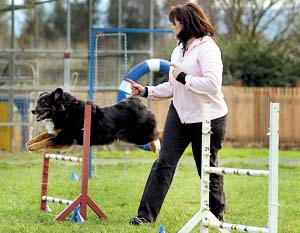
The Olympics may be just around the corner, but local canine
enthusiasts are gearing up for another sort of winter games.
Hollister – The Olympics may be just around the corner, but local canine enthusiasts are gearing up for another sort of winter games.
With the advent of Workin’ Paws, brainchild of Susan and Kraig Paulsen, Hollister pups and their owners will soon be leaping, crawling, climbing and weaving to their heart’s content.
Workin’ Paws is a dog agility training facility, part of one of the fastest-growing sports in the dog world, and the first of its kind in San Benito County. Essentially, dog agility competition gives dogs and owners alike a chance to compete and exercise together through mastering a series of obstacle courses designed to test the animal’s speed, endurance and intelligence.
“Agility training really creates teamwork between you and your dog,” said Susan Paulsen. “It’s priceless. You can’t just train a dog and have someone else go run it for you, it won’t work that way. It gets to the point where you and your dog can sort of read each other, you know what to expect from one another.”
For the Paulsens, Workin’ Paws is a dream come true. After nine years of study and competition at the regional, state and national levels, the couple knew they were committed to opening a facility of their own, making Workin’ Paws the 15th such center in Northern California. The reasonable price of land enabled the two to purchase enough property to set up a course, and hope to set up additional fields in the near future. The course is situated on their home near Spring Grove Road, spans 100 by 150 feet, and resembles a preschool playground more than an arena for doggy-style athletics.
“As you can see it’s a pretty addictive sport,” Paulsen said. “Not everybody needs to go out and buy five acres, though.”
Agility courses feature two basic types of obstacles: Jumpers, which challenge the dog to leap over an obstacle without knocking it down, and contact, which usually demands that the dog successfully scale a ramp or teeter-totter-type device. Competition requires that the dog accurately complete as many obstacles as possible as quickly as possible, and it can take years for an owner-dog team to master a course.
Workin’ Paws will be collaborating with agility clubs both large and small, such as the United States Dog Agility Association, the Australian Shepherd Club of America, and SMART, the Salinas Monterey Agility Racing Team. The space is available for owners to practice skills with their pets, and Paulsen will also be teaching “foundation” classes for those just learning about the sport.
“If you already have fabulous ‘sits’ and ‘stays,’ then foundation classes are a cinch,” she said. “But all of that gets covered in foundation, so anyone can start.”
Workin’ Paws will be holding a “Fun Match,” an informal contest offering dogs and their owners some real-world practice and an opportunity to socialize on Feb. 25. Paulsen will be holding her first series of real agility competitions beginning March 11, with competitions running until October. A coveted silver collar buckle will be awarded to the winning team in each class of competition – novice, open and elite.
“You’ll see people coming out from San Jose and Monterey,” Paulsen said. “I’ve even seen dedicated people come from as far away as Los Angeles.”
Dog agility is a fairly new sport, dating back only about 30 or 40 years, but has seen exponential growth in the past 10 or so years thanks to the televising of the bigger events and the accessible nature of the sport. Today, agility clubs hold regular events in almost all 50 states, as well as across Europe and Australia.
“The neat thing is that any dog can compete,” said Sue Graham, Chairperson of ASCA’s Agility Committee. “And you can practice anywhere, whether you’re setting up obstacles in your backyard or running back and forth with your dog in the hallway of your apartment.”
As far as canine hobbies go, says Paulsen, agility training is also a highly affordable hobby, with lessons running $12-15 per hour and obstacles easily made at home from PVC pipe or plywood. Of course, those who are truly set on competing at the international level can expect to invest a pretty penny in competition fees, travel and equipment.
Agility is also great for dog-lovers looking to drop a few pounds. Owners literally run their dog through every course, so even 20 or 30 minutes of practice offers a good workout for pup and person alike.
“You have to be in pretty good shape if you want to stay competitive,” Paulsen said. “You have to keep up with your dog.”
Currently, Paulsen holds down a day job as a junior high science teacher in Morgan Hill and, while she loves her job, would like to one day devote herself to Workin’ Paws full time.
“It’s taken some time, but I’ve learned that positive reinforcement is the best tool if you want your dog to compete well,” she said. “It works the same way with my students, you can’t just tell them they’re rotten and then expect them to excel… I guess I just have a knack for training mammals.”
For more information, check out http://www.workinpaws.com.
Danielle Smith covers education for the Free Lance. Reach her at 637-5566, ext. 336 or ds****@***********ws.com









